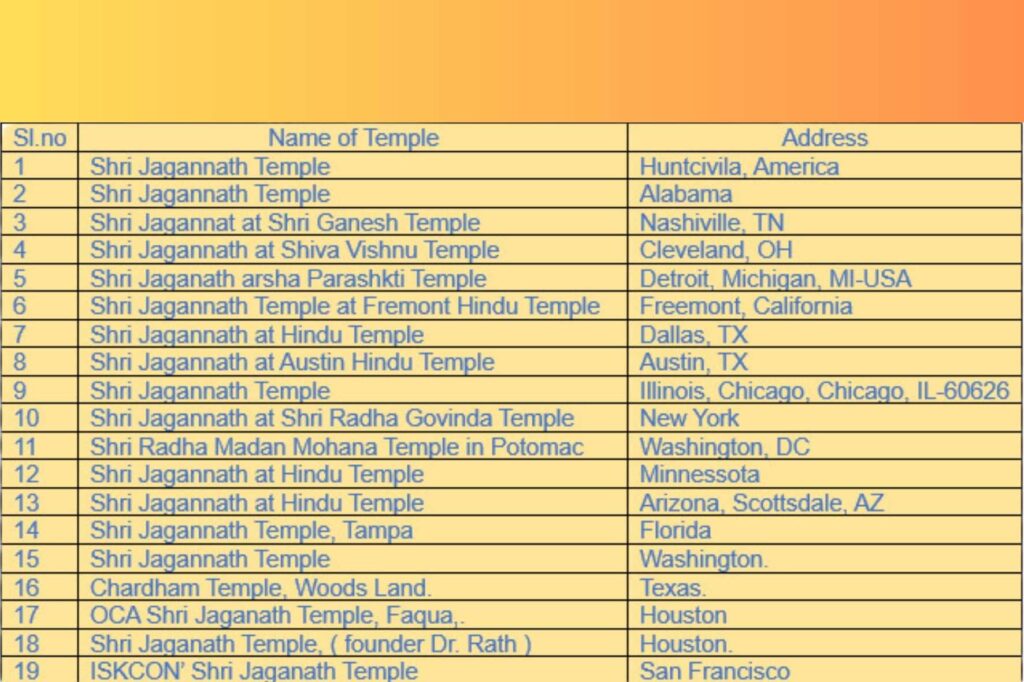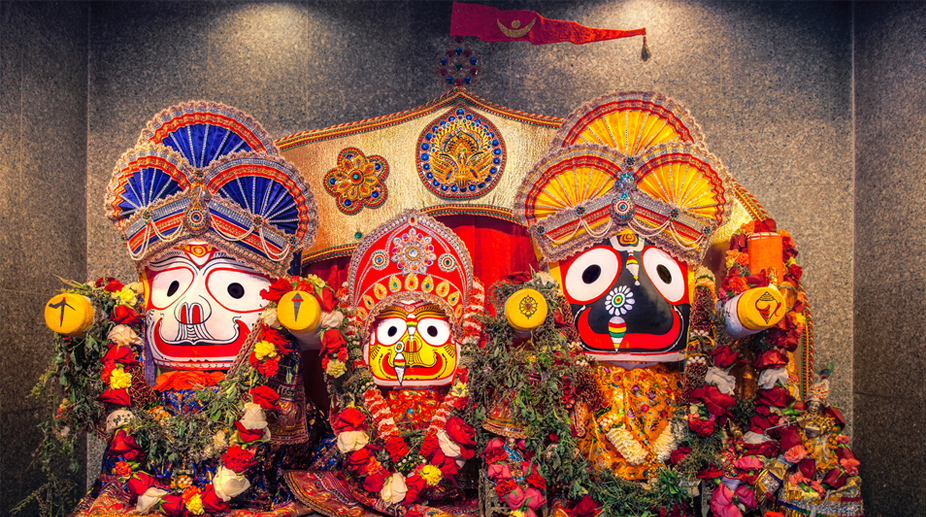By – Lokanath Mishra !
Jaganathah swami nayana-patha-gāmī bhavatu me. “This is a mantra for Prabhu Jagannātha. Jagannātha means ‘Lord of the universe. ‘ ‘O Lord of the universe, kindly be visible unto me”. Shri Jagannath is a deity worshipped in Hindu traditions in India and abroad as part of a triad along with his brother Balabhadra, and sister, Subhadra. Jagannath, within Odia Hinduism, is the supreme god, Purushottama and the Parama Brahman. To most Vaishnava Hindus, particularly the Krishnaites, Jaganath is Maha Vishnu, some devotees consider as the avatar of Krishna or Vishnu. Many believers have justified that the heart of Prabhu Shri Krishna is still kept in the Navi Kendra of Prabhu Shri Jaganath. To some Shaiva and Shakta Hindus, he is a symmetry-filled tantric form of Bhairava, a fierce manifestation of Shiva associated with annihilation.
Shri Jagannath main Temple is located at Puri , which is one of the most revered Vaishnava sites of worship in India. The present temple is one of the oldest Hindu temples to still be in use, the main shrine of the present temple was built by Anantavarman of the Chodaganga dynasty in the tenth century. The deities within the shrine, and the previous temple, however, are believed to be much older and are associated with the great mythical ruler of the Satya-yuga, King Indrayumn. At present there are about one thousand and five hundred Hindus temple in USA and out of these 1,500 temples, only fifty temples are Shri Jagannath’s temple in USA. The name of the few important Prabhu Shri Jaganath Temples located throughout the USA 🇺🇸 are furnished below:
Name of Temple & Address.

The oldest Jaganath temple was constructed/ established in Nashville , USA 🇺🇸 during the year 1992 by the Jagannath Society of America. Now a question may arise as to how Prabhu Shri Jaganath has entered into USA from Puri ? There is a very interesting story behind this. A devotee of lord Shri Krishna namely Shri Syamasundar ( not Shyamsundar Dasa) was living the life of an ascetic in Vrindavan (the sacred town of Krishna’s birth), painstakingly translating ancient Hindu texts into English. It was A.C. Bhaktivedanta Swami Prabhupada ( ISKCON) his own guru’s wish that he share the wisdom of their tradition — centered around Krishna bhakti, or devotion to Krishna — with the Western world.
Swami Prabhupada was the first Hindu preacher to take advantage of the removal of national quotas by the 1965 Immigration Act of the United States. In July 1966, he founded the International Society for Krishna Consciousness (ISKCON) in New York City. He defended the name, arguing that Krishna included all other forms and concepts of God. In 1967, a centre was started in San Francisco. He travelled throughout America with his disciples, popularising the movement through street chanting (sankirtana), book distribution and public speeches. George Harrison of The Beatles produced a recording with some of the devotees in London and helped establish the Radha Krisna Temple in that city.
Over the following years, his role as preacher and leader of the Krishna consciousness movement took him around the world several times setting up temples and communities in other countries. By the time of his death in Vrindavan in 1977, ISKCON had become an internationally known expression of Vaishnavism. Through his mission, he followed and preached the teachings of Chaitanya Mahaprabhu and introduced bhakti yoga to an international audience. Within Gaudiya Vaishnavism this was viewed as the fulfilment of a long time mission to introduce Caitanya Mahaprabhu’s teachings to the world.
During the year 1966, Shyamasundar duly securing free passage on a cargo steamship, he packed his translations into a steel trunk and boarded the vessel, leaving behind his home to voyage into the unknown. The journey was arduous, as he suffered intense sea sickness, dizziness, vomiting, and two heart attacks. When he arrived in New York City 37 days later, however, his resolve still had not wavered. Though he had no funds, no friends, no support, and weak health, he had a most powerful spiritual message, one he believed would transform the lives of any if they just gave it a chance.
He at last reached in America along with his wife Malati. Shyamasundar and Malati had joined a burgeoning community of USA — officially known as ISKCON (the International Society for Krishna Consciousness) — who were, in fact, giving the Swami his Guru and his teachings such a chance. Having already helped to establish a small temple for him in San Francisco, the couple, indeed experiencing the positive transformative results from implementing his spiritual practices, felt increasingly inclined to learn more of these teachings, and help him share them with others.
Shyamasundar noticed it one mid-February day of the year 1967 situated on the mantelpiece of the old iron fireplace in their apartment: a brightly painted wooden figurine standing roughly 3 inches in height. Black in complexion, with a wide euphoric smile, large beaming eyes, and no arms or legs, the object held an other-worldly look, sparking in him an immediate curiosity. What was it? he wondered. It was, his wife Malati explained, something she had found while browsing the local import shop. There were three wooden barrels near the cash register filled with such figurines of different colors. Particularly attracted to the black one, she had become especially compelled to bring it home when she saw the “Made in India” label attached on the bottom. India, after all, was where the Swami his Guru and himself had come from.
Finding a “Made in India” item during the ‘60s though wasn’t an everyday occurrence. Thus grabbing the figurine, Shyamasundar began making his way to the apartment they had set up for the Swami above the temple on Frederick Street. Even if it turned out to be of no significance, it would still serve as a good excuse to get some personal time with him. But, as Shyamasundar writes in his book Chasing Rhinos With The Swami: Volume 1, not only was the mysterious object significant, it had extraordinary importance, and way beyond what he would have imagined : Dropping the doll in his outstretched hand I said, “Swamiji, we found this in a shop. It’s from India. Can you tell us what it is?”
This startled look comes over the Swami’s face. He leaps from his rocker and places the doll on his metal trunk and falls down on the floor before it, beckoning “Down, down!” to Mukunda [another follower of the Swami] and me, who are trying to make sense of this. We bow down beside him. And then he starts praying in Sanskrit, saying, “jagannatha swami nayana patha gami bhave tu me” over and over. Flushed and beaming, the Swami rises and asks me, “From where have you got this doll?” “Malati found it.”
“Then tell her to come here immediately.”
The figurine, the Swami told them once Malati arrived and explained where she had found it, was Krishna in his form as Jagannatha. And the figurines in the other two barrels were his brother Baladeva, and their sister Subhadra. In ancient times, the Swami continued, there was a king named Indradyumna who was anxious to worship Krishna in a form considered especially magnanimous. Krishna, wanting to reciprocate with his devotee, spoke to the king in a divine occurrence, telling him that he should go to a specific part of the beach on the Bay of Bengal, where he would find a huge reddish log from which such a form, along with the forms of his brother and sister, should be carved. Finding the log, the king had many sculptors attempt to carve the wood, but all of their tools broke as soon as they came in contact with it. Eventually an old man, who was actually Krishna in disguise, put his chisel to the log and, to the jubilance of the king, immediately made a mark. Agreeing to carve the deities, the man told the king it would take him 21 days to complete the task, and that he would do it on the condition he could carry it out in complete privacy, without disturbance from anyone. Originally consenting to the stipulation, the king, after 14 days, became overcome by curiosity when he heard no sound coming from the workplace, spurring him to enter prematurely. Inside, he found the man was gone, and what was left were the three forms, unfinished, without arms or legs, exactly as they appear today.
Concluding the story, the Swami looked at the three of them and asked if there was anyone who could carve larger versions of the figurines Malati had found, indicating a height of about 3 feet. Once finished, he would formally install them in the temple there, where they could be regularly worshiped according to scriptural guidelines. A trained carpenter, Shyamasundar immediately said he could do it. Eager for the opportunity to help fulfill a vision so obviously important to the Swami, he made his way to a wrecking yard not long after leaving the apartment, and with the help of a couple other devotees, managed to find a Douglas fir timber from a dismantled barge — a single large piece of wood, in other words — big enough to carve all three deities out of. Loading it into their van, they brought it back to Shyamasundar’s apartment, where he cut the slab of wood into three 4-foot sections and began work on the task, immersing himself in the meditation of the service, making sure to appreciate every moment of the process.
A few weeks later they were done, ready for the March 23 date the Swami had set for the installation. Placed on a newly constructed altar in the temple, the deities were offered their first formal worship, making them ISKCON’s first ever officially installed deities. Addressing the crowd of devotees who had assembled for the occasion, the Swami told them Jagannatha’s manifestation in San Francisco was no coincidence. Known as “Lord of the Universe,” he is a particularly compassionate form of Krishna, who is accepting of all, regardless of where they are on their spiritual path, and thus an especially appropriate deity for ISKCON’s swiftly expanding community of new devotees.
Just as he had appeared on the Indian coast to reciprocate with the devotional aspirations of the king, he had now appeared on the coast of the Pacific to reciprocate with the devotional aspirations of San Francisco’s growing community. And just as his temple in Orissa on the Indian coast is called Jagannatha Puri, the temple in San Francisco would now be called New Jagannatha Puri. Meanwhile Malati ascertained from the store where Shri Jagannatha’s idol was discovered that the owner of the store once visited Puri and one tourist guide namely Tthukuri ( a trailer of Puri Dolamandapa sahi) had donated all the three idols to him. Thus the ISKCON’s Shri Jaganath Temple of San Francisco is the first Shri Jaganath Temple in USA.

